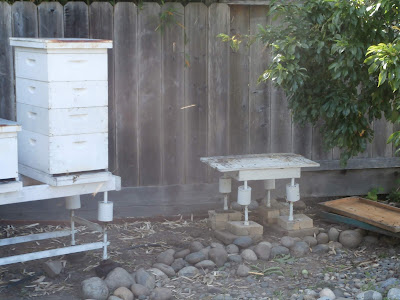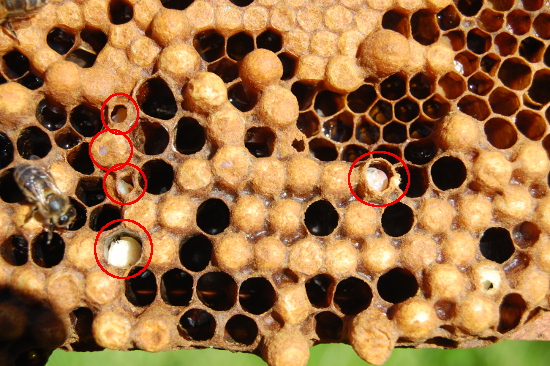This is what I saw when I looked at the swarm trap 6 days ago. A swarm had moved in while we were away from the house. I knew I had to transfer it to it's new hive. This had to be done soon before much comb was built. Since I had never done this before, I had no idea on how to go about it. An online search resulted in no useful advice.
That afternoon, I prepared the swarms new home. One deep box with 10 frames of drawn comb in #3 position. I placed
Ant Moats under the legs of the stand. (I saw these a few weeks ago when I helped Dinah with her bees. They are neat and effective. I bought enough for all my hives.)
So... I wanted to transfer all the bees, so it had to be done before the foragers started their jobs. I went out when it was dark and plugged the entrance hole. While on the ladder, I tapped the trap and was satisfied to hear an answering hum.
I still intended to transfer them before their work-day began, so-
I arose early and went out at
first light. I carefully lowered the trap, noting that it was not very heavy. I carried it into the back. I opened the hive and removed the middle 8 frames. Since I did not know in which half of the trap they would be clustered, I placed the trap in a box, where I unscrewed the halves and opened it.
 |
| Trap in a box near the hive |
The bees were all clustered in the top part. In retrospect, I should have know this would be the case.
Placing the pot into the hive, I have it a sharp shake. The bees tumbled into the hive and started to climb up the side frames.
 |
| The small swarm in their new home |
Of course, not all the bees left the pot. After a few more shakes and raps, I left the pot nearby so that the straggles would be able to fly to the new home. The bees had already built a small amount of comb.
I replaced the frames and closed up.
Whenever I had captured a swarm, I noted that 100-200 bees would return to the cluster spot. This occurred here as well, even though I had placed grass across the entrance. I had read that when moving a hive, placing grass across the entrance encourages the bees to re-orient.
I think that these must be scouts. The oldest foragers search for a new home. When they reach a consensus, they lead the swarm to it. They have the location wired into their little brains, so when the leave the new hive, they follow the path back to the old spot.
It had only been 5 days since the transfer, but my curiosity overcame by caution. I went in. The bees only covered 4 frames. There was some nectar. And I saw the queen! She is large and moderately dark. I watched as she laid and egg and saw some other eggs, no larvae.
I looked into #1 also. There is brood in all 3 boxes. The 2 mediums have worker brood and it looks like it might be spotty. I will need to do a mite count after we return from our upcoming trip. The bottom box had some drone brood. There was some honey being made in all three boxes. I added a super with foundation only frames.


















































